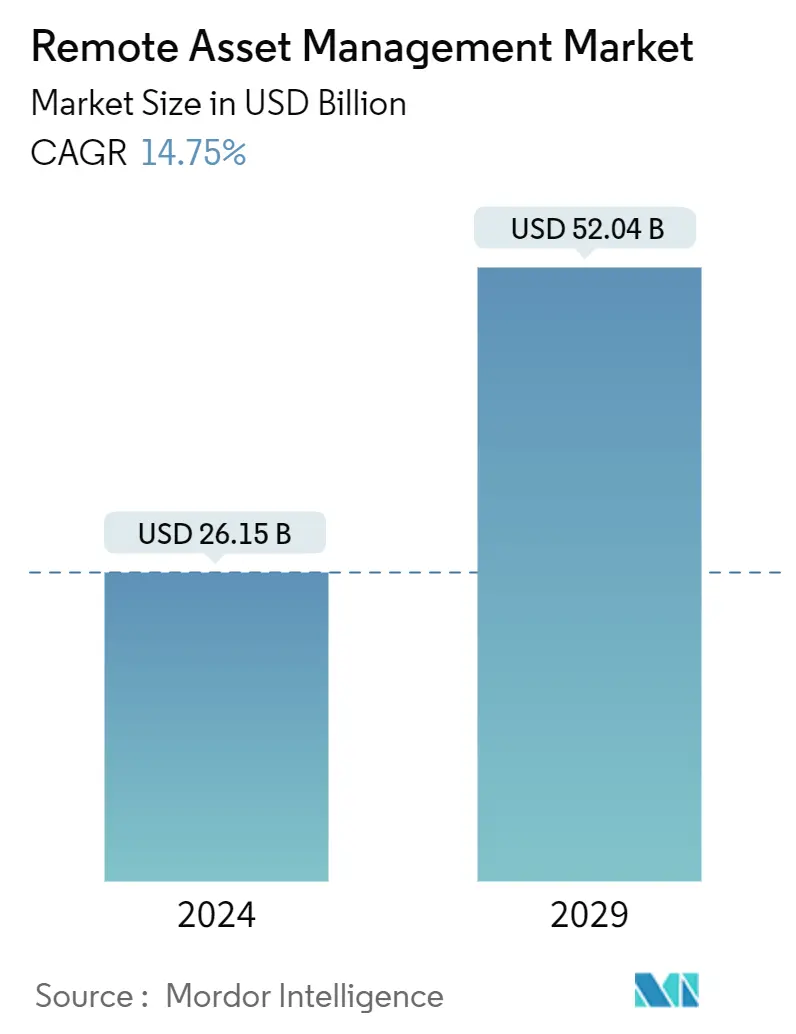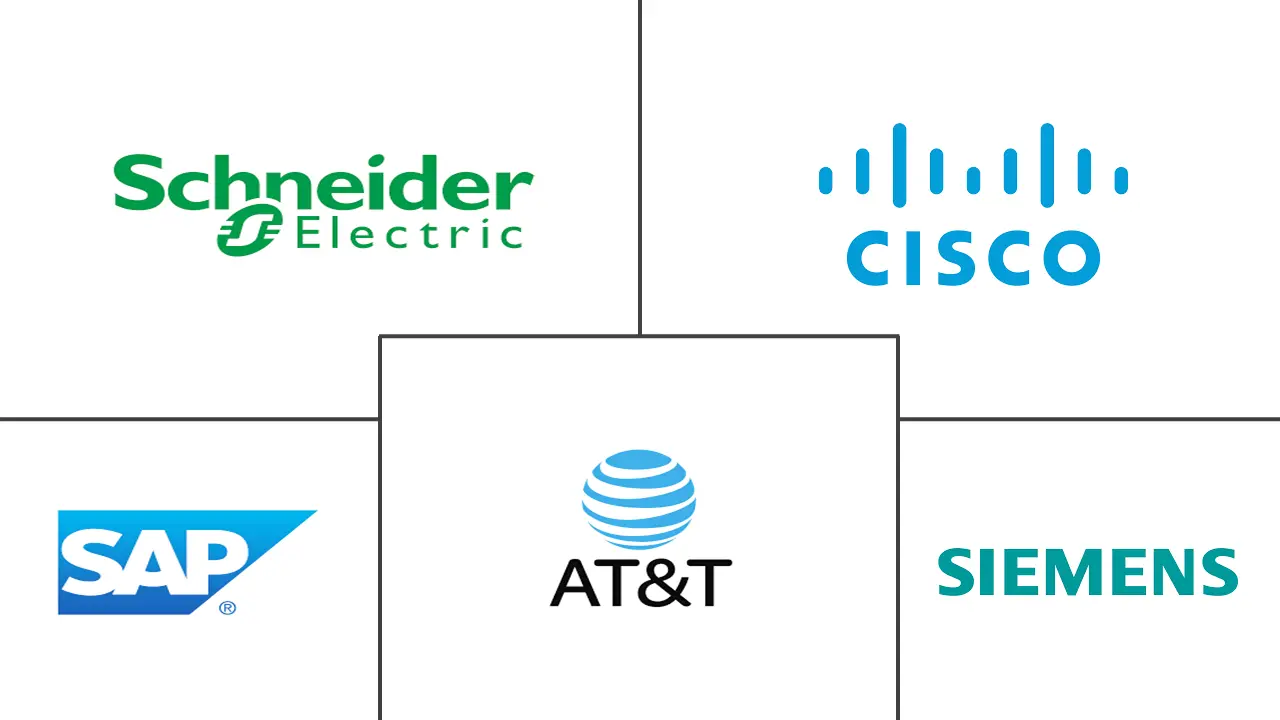Market Size of Remote Asset Management Industry

| Study Period | 2019 - 2029 |
| Market Size (2024) | USD 26.15 Billion |
| Market Size (2029) | USD 52.04 Billion |
| CAGR (2024 - 2029) | 14.75 % |
| Fastest Growing Market | Asia Pacific |
| Largest Market | North America |
Major Players
*Disclaimer: Major Players sorted in no particular order |
Remote Asset Management Market Analysis
The Remote Asset Management Market size is estimated at USD 26.15 billion in 2024, and is expected to reach USD 52.04 billion by 2029, growing at a CAGR of 14.75% during the forecast period (2024-2029).
Remote asset management refers to remotely monitoring and managing assets, such as machines and equipment. It involves using various technologies to collect data from these assets and then analyzing them to optimize their performance and reduce downtime. In the manufacturing, energy and transport sectors, where resources can be more efficiently used as well as extending the life of important equipment, remotely managing assets has become a key issue.
- The primary drivers driving the need for remote asset management are predictive maintenance, loT-enabled remote asset management solutions, and the lowering cost of IoT-based sensors, which in turn reduces operational expenses of remote assets by increasing the use of remote asset management. Remote asset management enables real-time two-way communication between the organization's assets and the central monitoring application to improve asset management and control.
- Asset Performance Management (APM) is a comprehensive collection of solutions and services that includes software for monitoring variables such as asset health and reliability. They are also used to plan asset maintenance and divestiture strategies. For example, General Electric's Predix system contains many components, such as APM Health, APM Reliability, APM Strategy, and APM Integrity. APM systems deliver numerous insights at the point of action to extend asset life, eliminate unscheduled repair work, decrease downtime, lessen maintenance costs, and reduce the chance of equipment failure.
- Further, the software used is remote asset management, allowing two-way communication between the central application and the asset for improved management control. This remote asset management industry offers a variety of potential applications for expanding business opportunities. The Management System monitors and tracks the assets over the centenary using Vodafone SIMS. The Vodafone remote asset management system aids in transacting, developing businesses, and maintaining machinery, assets, and systems.
- Moreover, cloud computing services are becoming more affordable; internet access is improving; components are becoming less expensive; and governments in both developed and developing regions are increasing their investments in ICT. These reasons are projected to fuel significant demand for remote asset management in the short and long term. Rising smartphone adoption, internet penetration, and loT advancements drive the remote asset management market.
- The high cost of asset management solutions is expected to hamper the remote asset management market expansion.
- COVID-19 caused lockdowns in many nations, resulting in a drop in demand for Real-time location system RLTS solutions from many industries like autos, supply chain, and transportation. Many logistic organizations and supply chains, as were the automobile and transportation sectors, were completely shut down, leaving only the healthcare industry to thrive. Many mechanical tools and monitoring devices were required in the healthcare business to show data on a live monitor or save it on a database log for subsequent study.
Remote Asset Management Industry Segmentation
Remote asset management allows remote monitoring and maintenance for organizations across different sectors of resources, machines, and systems. Due to predictive and preventive maintenance, implementing a remote asset management solution enables businesses to enhance operational efficiency. Implementing a remote asset management solution helps improve machinery's general effectiveness, resulting in better asset management and control. Companies have adopted remote asset management to enhance remote asset approval and decrease maintenance costs.
The remote asset management market is segmented by component (solution, services), type( fixed asset, mobile asset), deployment mode (on-premise, cloud), end-user (manufacturing, healthcare, transportation & logistics), and geography (North America, Europe, Asia-Pacific, Latin America, Middle East, and Africa).
The market sizes and forecasts are provided in terms of value (USD) for all the above segments.
| By Component | |||||||
| |||||||
| Services |
| By Type | |
| Fixed Asset | |
| Mobile Asset |
| By Deployment Mode | |
| On-Premise | |
| Cloud |
| By End-User | |
| Manufacturing | |
| Healthcare | |
| Retail | |
| Energy and Utilities | |
| Transportation and Logistics | |
| Other End-Users |
| By Geography | |
| North America | |
| Europe | |
| Asia-Pacific | |
| Latin America | |
| Middle East and Africa |
Remote Asset Management Market Size Summary
The remote asset management market is poised for significant growth, driven by the increasing need for efficient monitoring and management of assets across various industries such as manufacturing, energy, and transportation. This technology leverages IoT-enabled solutions and predictive maintenance strategies to optimize asset performance, reduce downtime, and extend the lifespan of critical equipment. The integration of advanced software solutions, like Asset Performance Management (APM) systems, plays a crucial role in providing real-time insights and facilitating proactive maintenance strategies. The market is further bolstered by the decreasing costs of IoT sensors and the growing adoption of cloud computing services, which enhance connectivity and data analysis capabilities. Despite the high initial costs of asset management solutions, the long-term benefits in operational efficiency and cost reduction are driving widespread adoption.
North America is expected to dominate the remote asset management market, supported by its advanced technological infrastructure and skilled workforce. The region's growth is further propelled by the increasing number of connected devices and the strategic initiatives undertaken by governments to enhance digital operations. The market is characterized by a fragmented landscape with numerous vendors investing in research and development to innovate and expand their offerings. Companies are also focusing on global expansion to capture a larger market share. The adoption of artificial intelligence in remote asset management solutions is enhancing operational efficiency and reducing costs, while partnerships and collaborations, such as those between Drishya AI Labs and VEERUM, are facilitating the integration of digital twin technology for improved asset management.
Remote Asset Management Market Size - Table of Contents
-
1. MARKET INSIGHTS
-
1.1 Market Overview
-
1.2 Industry Value Chain Analysis
-
1.3 Industry Attractiveness - Porter's Five Forces Analysis
-
1.3.1 Bargaining Power of Suppliers
-
1.3.2 Bargaining Power of Consumers
-
1.3.3 Threat of New Entrants
-
1.3.4 Threat of Substitutes
-
1.3.5 Intensity of Competitive Rivalry
-
-
-
2. MARKET SEGMENTATION
-
2.1 By Component
-
2.1.1 Solution**
-
2.1.1.1 Real Time Location System
-
2.1.1.2 Analytics and Reporting
-
2.1.1.3 Asset Performance Management
-
2.1.1.4 Surveillance and Security
-
2.1.1.5 Other Solutions (Network Bandwidth Management, Mobile Workforce Management)
-
-
2.1.2 Services
-
-
2.2 By Type
-
2.2.1 Fixed Asset
-
2.2.2 Mobile Asset
-
-
2.3 By Deployment Mode
-
2.3.1 On-Premise
-
2.3.2 Cloud
-
-
2.4 By End-User
-
2.4.1 Manufacturing
-
2.4.2 Healthcare
-
2.4.3 Retail
-
2.4.4 Energy and Utilities
-
2.4.5 Transportation and Logistics
-
2.4.6 Other End-Users
-
-
2.5 By Geography
-
2.5.1 North America
-
2.5.2 Europe
-
2.5.3 Asia-Pacific
-
2.5.4 Latin America
-
2.5.5 Middle East and Africa
-
-
Remote Asset Management Market Size FAQs
How big is the Remote Asset Management Market?
The Remote Asset Management Market size is expected to reach USD 26.15 billion in 2024 and grow at a CAGR of 14.75% to reach USD 52.04 billion by 2029.
What is the current Remote Asset Management Market size?
In 2024, the Remote Asset Management Market size is expected to reach USD 26.15 billion.

